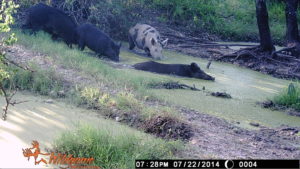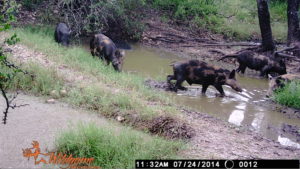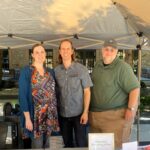By Gabriela Rodriguez
As Texas A&M University-San Antonio campus keeps expanding, the feral hog population does the same. The optimal summer weather with plenty of rain, an installed irrigation system around Main Campus and food available around the 694 acres the school owns attracts feral hogs instead of pushing them away.
Assistant professor of biology Jose Rodolfo Valdez-Barillas has observed, studied and worked with students to better understand the feral hogs.
Feral hogs around campus are not a surprise, he says.
“It’s the nature of where we’re located; we have to learn to live around them,” Valdez-Barillas said.
Groups of about 12 feral hogs, mostly sows and piglets, roam around the land together while male feral hogs roam by themselves or in small groups. A sow can start reproducing by nine months of age and can produce five to seven offspring two to three times annually, he said.
According to research done in 2012 by Valdez-Barillas, results showed the piglet population for 2016 would reach 600 and adult-female and male feral hogs could reach 175.
The feral hog population is one of the fastest growing and Valdez-Barillas can see a significant spike in population growth in the next four to five years.

Javelinas, hogs and boars usually get confused and the terms misused. Feral hogs have longer tails and are descendents of domestic hogs and wild boars. Javelinas are not related to pigs and have not been spotted anywhere around A&M-San Antonio.
Hogs have a long history in the region. The first domesticated hogs were brought by Spaniards in the mid-1500s and gradually became wild as they escaped their domestic habitat.
Later in 1930, Russian boars, or European wild hogs, were brought to America for sports hunting, eventually crossing with feral hogs once they escaped from their ranches, according to Valdez-Barillas’ research.
Valdez-Barillas commends the in-house gardening team since they’ve kept up with damages feral hogs have caused.
Usually a feral hog tends to be a “disruptive animal,” Valdez-Barillas said.
Facilities director David Wagner works directly with a team of four gardeners who keep up with any damage the feral hogs do around campus.
These damages are usually caused when feral hogs are “rooting,” which is when they use their nose to dig and locate food as deep as two feet and chew on the roots of plants to get water. In the past feral hogs’ acute sense of smell was used for truffle hunting.
All research and surveillance done by Valdez-Barillas is supported by camera traps along hog trails and drone assisted surveillance. They are mostly observed around puddles, a couple of ponds located around campus or lakes, such as Canvasback Lake located 1.2 miles away from Main Campus at 6 p.m. once the sun goes down. During sunny hours, they tend to hide in the shade of a tree and avoid activity.
When it comes to dealing with the feral hog population, “there’s no quick, easy solution,” Valdez-Barillas said.
The single-trapping method implemented at A&M-San Antonio costs $12,000 annually. It’s a a time-consuming and ineffective method that only traps one or two adult feral hogs, based on calculations made by Valdez-Barillas.
He recognizes corral traps as a more effective method, which is a large round metal cage with bait in the middle to attract feral hogs. Once the corral is full, the cage lowers and traps the hogs. To implement this method the cost would be around $1,445 for setting each cage and $384 for corn bait. 
Nevertheless, fencing is the most expensive but most effective method costing around $2,000-$8,000 per mile. The fencing would specifically need to be woven wire fence, four to six feet buried underground and a T-post spaced every 12 feet, Valdez-Barillas said.
Valdez-Barillas considers there hasn’t been much interest in getting rid of the hogs since they are not a liability to the school, but once students start living on-campus, something will have to be done.
Communication junior Kaylee Jackson had a brief sighting of about 12 feral hogs around 9 p.m. on the side of University Way when she was leaving after a late evening class in early October.
Jackson, a hunter by trade who lives in the country with her family, knows all about the problems feral hogs cause.
“They can be aggressive,” she said.
A problem with its overpopulation is nothing new to Jackson since she recalls having to hunt them in her 50 acres in Floresville. The main purpose was to avoid them attacking dogs, cats and deer as well as eating plants and tearing up property.
Jackson, who is used to dealing with feral hogs admits, “I was a little freaked out,” when she saw them so close to the road.
The night Jackson observed the feral hogs, one was almost on the street, “potentially somebody could’ve hit it,” she said.
Construction of new buildings disrupts the already established routes they have, making them move around even more.
“They’re probably just scared,” Jackson said.
If there is an encounter with feral hogs, be sure to call the University Police Department at 210-784-1900.
“Don’t take selfies with them,” Valdez-Barillas said.






